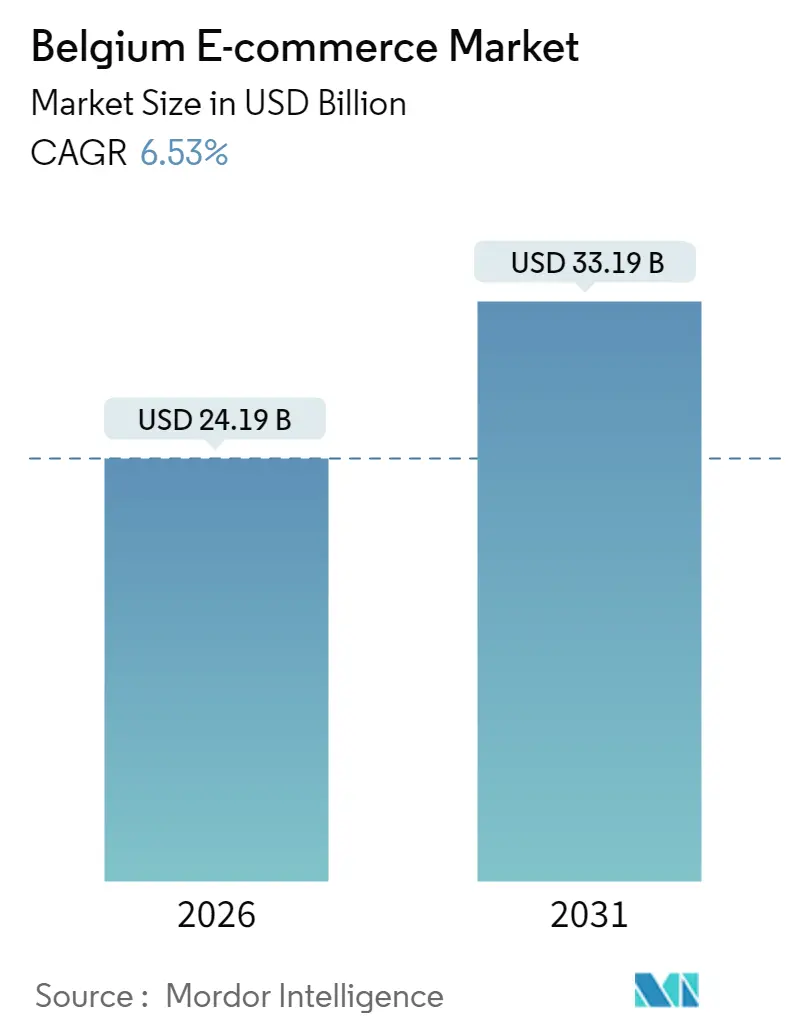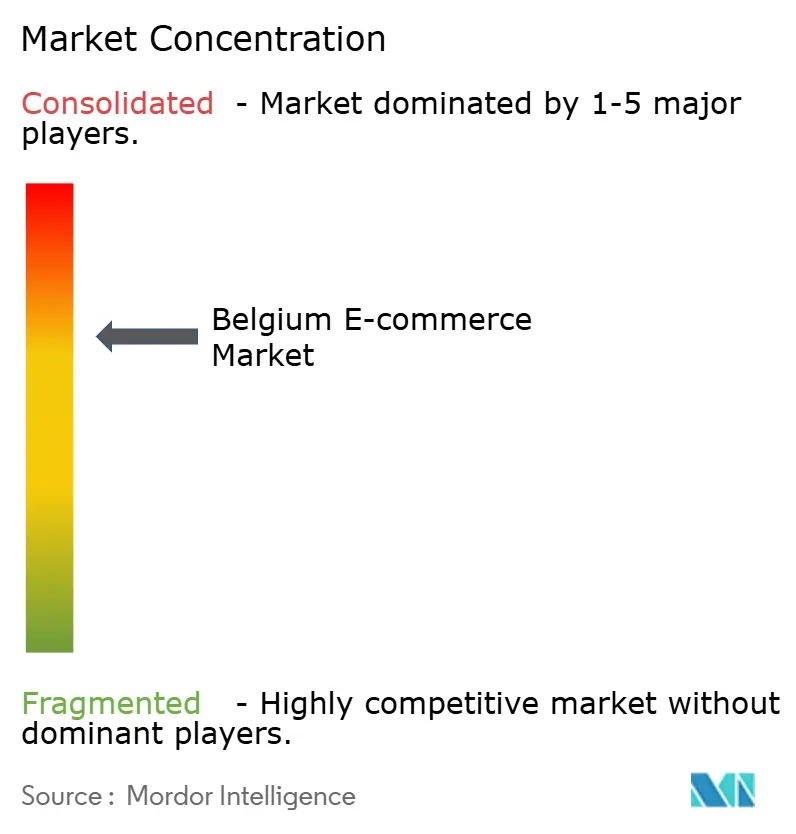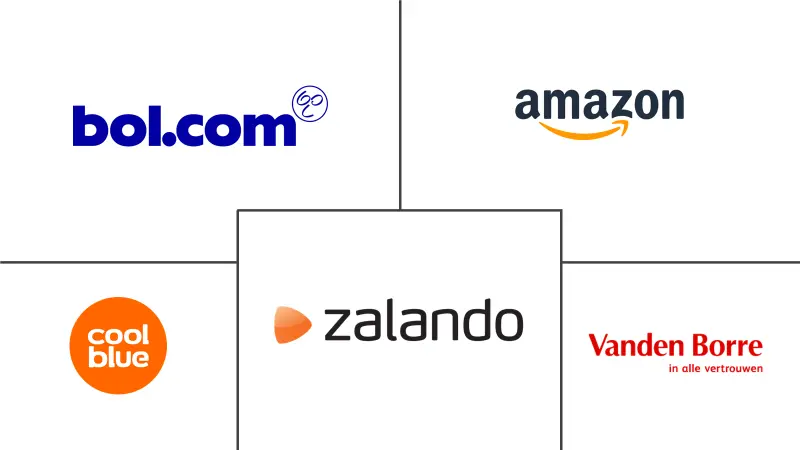
Belgium E-commerce Market Analysis by Mordor Intelligence
The Belgium e-commerce market is expected to grow from USD 22.71 billion in 2025 to USD 24.19 billion in 2026 and is forecast to reach USD 33.19 billion by 2031 at 6.53% CAGR over 2026-2031. Investors view this trajectory as the direct outcome of near-universal broadband coverage, high smartphone saturation, and a regulatory agenda that actively promotes digital trade. Growing consumer trust in online checkout, the rollout of mandatory B2B e-invoicing in 2026, and continual upgrades to parcel infrastructure create a reinforcing cycle of demand and supply innovation. Cross-border purchasing already represents more than one-third of all Belgian online spend, positioning the country as a regional gateway for pan-European sellers. Payment diversification, highlighted by the rapid ascent of Buy Now Pay Later (BNPL) and real-time account-to-account services, signals a shift from convenience toward flexibility as a core buying motive. Retailers that orchestrate friction-free delivery and transparent sustainability credentials are capturing incremental wallet share, especially in urban corridors.
Key Report Takeaways
- By business model, B2C held 88.45% revenue share in 2025, while B2B is projected to grow fastest at 8.21% CAGR through 2031.
- By device type, smartphones generated 57.30% of 2025 sales; desktops record the highest forecast CAGR at 8.06% through 2031.
- By payment method, cards drove 36.60% of 2025 volume; BNPL is on track for a 13.8% CAGR to 2031.
- By B2C product category, fashion & apparel led with 28.30% of Belgium e-commerce market share in 2025; food & beverages expands at 9.3% CAGR to 2031.
Note: Market size and forecast figures in this report are generated using Mordor Intelligence’s proprietary estimation framework, updated with the latest available data and insights as of January 2026.
Belgium E-commerce Market Trends and Insights
Drivers Impact Analysis
| Driver | (~) % Impact on CAGR Forecast | Geographic Relevance | Impact Timeline |
|---|---|---|---|
| Dense National Logistics Network Enabling Same-Day Delivery Expectations | +1.8% | National, with concentration in urban centers | Medium term (2-4 years) |
| Rapid EU Cross-border Shopping Adoption Among Belgian Consumers | +1.5% | National, with higher impact in border regions | Short term (≤ 2 years) |
| Government-Backed Digital Voucher & Cashback Schemes for SMEs | +1.2% | National, with stronger effects in Wallonia | Medium term (2-4 years) |
| Accelerating Click-and-Collect Integration by Brick-and-Mortar Chains | +0.9% | National, with concentration in urban centers | Short term (≤ 2 years) |
| Source: Mordor Intelligence | |||
Dense national logistics network enabling same-day delivery expectations
Belgium’s compact geography and world-class transport grid shrink the distance between fulfillment centers and doorsteps. Parcel leader bpost now covers Brussels, Antwerp and Ghent with fully electric vans, while cargo-bike operators cut peak-hour delays in narrow streets.[1]Ingrid, “E-commerce Last-Mile Delivery Landscape in Belgium 2025,” ingrid.com The 2024 delivery law obliges merchants to disclose CO₂ output and present at least one low-emission option, pushing carriers to redesign route algorithms. Consumer surveys show 60% preference for eco-friendly delivery without compromising speed. Retailers meeting the twin requirement of velocity and sustainability report conversion lifts that offset higher last-mile costs. As more hubs switch to automation, same-day and even two-hour slots move from novelty to baseline in core metropolitan zones.
Rapid EU cross-border shopping adoption among Belgian consumers
With three official languages, open borders and shared payment rails, Belgian shoppers seamlessly browse neighboring portals. Cross-border turnover hit EUR 5.5 billion (USD 6.05 billion) in 2024, equal to 35.5% of all domestic online revenue.[2]International Trade Administration, “Belgium — eCommerce,” trade.gov Dutch and German sellers exploit proximity by guaranteeing duty-paid delivery within two days. This inflow intensifies pricing pressure on local merchants but also encourages them to export through pan-EU listings. Logistic providers have reacted by adding multilingual tracking and consolidated returns centers along the Leuven-Liège axis. The result is a virtuous circle where Belgian buyers expand assortment choice while local SMEs gain streamlined access to continental demand.
Government-backed digital voucher & cashback schemes for SMEs
Wallonia’s “Digital Maturity” voucher reimburses up to EUR 50,000 (USD 55,000) of advisory fees over three years.[3]Wallonia Region, “Digital Maturity Voucher,” wallonie.be At federal level, the 2025 investment deduction allows a 20% base write-off on software, rising to 120% for micro-enterprises adopting structured e-invoicing. These levers lower capex hurdles for first-time webshops and catalyze cloud migration. SME associations report a 30-40% uplift in online turnover within 18 months of voucher receipt, suggesting the subsidy directly widens the Belgium e-commerce market. Importantly, such aid stimulates third-party developer ecosystems, spawning SaaS storefronts, reg-tech tools and last-mile analytics tailored for smaller merchants.
Accelerating click-and-collect integration by brick-and-mortar chains
Branded store networks transform into hybrid fulfilment nodes that bridge web convenience with instant pickup. Carrefour Belgium’s cashier-less “BuyBye” micro-store pilots illustrate the shift toward 24/7 self-service formats. Omnichannel shoppers spend 15-30% more per visit, so grocery, DIY and electronics chains now allocate dedicated front-of-house lockers and automated returns kiosks. The operational upside—reduced shipping costs per order—compensates for the capex in robotics, making click-and-collect an earnings accretive strategy that deepens customer stickiness.
Restraints Impact Analysis
| Restraint | (~) % Impact on CAGR Forecast | Geographic Relevance | Impact Timeline |
|---|---|---|---|
| Persistently High Preference for In-store Payment & Pick-up in Flanders | -0.8% | Regional, concentrated in Flanders | Medium term (2-4 years) |
| Scarcity of Domestic Pure-Play Marketplaces Limiting Merchant Choice | -0.7% | National | Long term (≥ 4 years) |
| Urban Last-Mile Congestion Surcharges Increasing Fulfilment Costs | -0.5% | Urban centers, particularly Brussels | Short term (≤ 2 years) |
| Source: Mordor Intelligence | |||
Persistently high preference for in-store payment & pickup in Flanders
Cultural comfort with physical checkout lingers. Nearly half of Flemish online carts are abandoned over payment-security worries, double the rate in Wallonia. Retailers that cannot mirror web-to-store flows risk lower conversion, forcing them to maintain dual inventory logic and staff cash points. While local banks promote strong customer authentication, behavioral change remains gradual, tempering full-digit migration in Belgium e-commerce market hotspots.
Scarcity of domestic pure-play marketplaces limiting merchant choice
Foreign marketplaces—Bol.com, Zalando and Amazon—dominate, leaving few homegrown alternatives. The Belgian Competition Authority warns that excessive reliance on external platforms can lead to higher commission fees and algorithmic self-preferencing. Small sellers therefore juggle multiple dashboards, increasing complexity and diluting brand identity. Without domestic champions, data on consumer insight also flows abroad, limiting national bargaining power within the broader Belgium e-commerce industry.
Segment Analysis
By Business Model: B2B digitalization accelerates growth
The B2C segment retained 88.45% share of the Belgium e-commerce market in 2025, fuelled by 94% internet penetration and a customer base that already conducts weekly errands online. Cross-border sourcing supplements domestic catalogues, ensuring sustained SKU variety. As same-day fulfilment scales, discretionary categories such as fashion enjoy repeat-purchase stickiness. Nevertheless, the B2B corridor now posts an 8.21% compound growth rate, outstripping overall momentum. The impending 2026 e-invoicing mandate obliges every taxable entity to adopt structured XML invoices, pushing procurement onto digital rails and enlarging the Belgium e-commerce market size attached to corporate purchasing. Suppliers that integrate catalog syndication, punch-out APIs and automated tax compliance stand to monetise order-spread once locked into multi-year supply contracts. With fiscal incentives granting up to 120% write-offs for invoicing software, micro-enterprises in construction, wholesale and professional services migrate en masse, giving the Belgium e-commerce market fresh tailwinds through 2031.

Note: Segment shares of all individual segments available upon report purchase
By Device Type: Mobile commerce dominates consumer engagement
Smartphones accounted for 57.30% of transactions in 2025 and continue to chart a 7.74% CAGR, mirroring global shifts toward “thumb economy” behaviour. Payment tokens, biometric log-in and one-click wallets compress checkout friction, especially for impulse buys under EUR 50 (USD 55). Social discovery also pivots to vertical-video feeds, with 43% of Belgians relying on YouTube reviews before purchase. Desktops, while losing share, retain relevance for high-ticket electronics and complex B2B orders requiring multi-tab comparisons. Tablets and wearables add incremental sessions during leisure periods, diversifying traffic sources and lengthening the customer journey. Collectively, the rising mix of endpoints expands the Belgium e-commerce market size without cannibalising existing channels, as households oscillate between convenience and detail depending on need-state.
By Payment Method: BNPL disrupts traditional payment landscape
Cards maintained 36.60% volume in 2025, underpinned by 3-D Secure upgrades and contactless familiarity. Bancontact remains the trusted domestic overlay, used by seven in ten online shoppers for bank-account-to-bank-account transfers. Digital wallets rose five percentage points in five years, tapping growing comfort with tokenised credentials. The breakout, however, is BNPL, predicted to grow 13.8% annually through 2031. Upcoming EU credit rules will lift transparency and risk scoring, positioning BNPL as a regulated mainstream product rather than a fringe alternative. For merchants, basket uplift often offsets the interchange saved on cards, making BNPL integration a strategic upsell lever that enlarges retailer share of the Belgium e-commerce market.

Note: Segment shares of all individual segments available upon report purchase
By B2C Product Category: Food & beverages disrupts fashion’s dominance
Fashion still leads with 28.30% of spend, yet online share can climb to 73% by 2029 as augmented-reality sizing and carbon-neutral returns improve fit confidence. Luxury lines adopt recycled fabrics, while fast-fashion deploys limited-drop capsules to trigger urgency. Food & beverages, once hampered by logistics and freshness constraints, now secures the fastest 9.3% CAGR, thanks to dark-store micro-fulfilment and temperature-controlled lockers at transit hubs. Consumer electronics, beauty and DIY each hold resilient pockets, aided by tutorial-rich content and influencer partnerships. The widened category mix underlines how the Belgium e-commerce market evolves from discretionary spend toward habitual replenishment, expanding total addressable value.
Geography Analysis
Flanders hosts 71.65% of online storefronts, leveraging dense warehouse clusters along the E313 and robust port connectivity at Antwerp. Nonetheless, the region’s attachment to pay-in-store habits moderates digital-only conversion, making omnichannel orchestration mandatory. Wallonia, in contrast, accelerates on the back of voucher-powered SME onboarding; Liège’s cargo airport and Trilogiport inland terminal anchor cross-border fulfilment corridors. Walloon exporters derive 69.20% of revenue outside Belgium, illustrating how e-commerce meshes with historic outward-looking trade culture.
Brussels acts as regulatory and logistics nerve-centre. Its multilingual talent pool attracts fintechs designing PSD2-compliant rails and reg-tech focused on VAT reconciliation, both critical for scaling the Belgium e-commerce market. The capital’s night-delivery pilots test consolidation hubs that merge multiple merchant parcels into single green-zone runs, offering a blueprint for congestion-capped cities.
From a continental perspective, Belgium occupies a strategic parcel crossroads. Proximity to the Dutch A12 and German A3 corridors means next-day delivery is feasible to 80 million EU consumers. Consequently, 55.40% of Belgian shoppers import regularly, with savings on list price outweighing modest return inconveniences. EU sustainability legislation requiring two delivery options, one low-carbon, nudges carriers to pool networks, raising service uniformity across regions and bolstering shopper confidence in the Belgium e-commerce market.
Competitive Landscape
Market leadership concentrates around three retail portals—Coolblue, Bol.com and Shein—that together record a double-digit slice of 2024 GMV. Each exploits particular strengths: Coolblue’s service-led proposition, Bol.com’s marketplace network and Shein’s algorithmic fashion drops. Traditional chains respond by upgrading e-commerce engines: MediaMarktSaturn targets EUR 45 million (USD 49.5 million) in retail-media revenue by 2026, turning site traffic into high-margin ad slots. Carrefour deploys autonomous micro-stores to pair online baskets with instant pickup. Domestic logistics provider Bpost accelerates vertical integration, acquiring Active Ants to bundle fulfilment and last-mile under one SLA.
White-space potential lies in niche marketplaces for circular fashion, local artisans and B2B maintenance supplies where existing giants lack depth. SaaS vendors supplying composable commerce and AI merchandising position themselves as enablers rather than direct competitors, riding volume without inventory risk. Meanwhile, regulatory scrutiny on foreign platform dominance could level fees for Belgian sellers, slightly diluting incumbents’ moat while broadening merchant options in the Belgium e-commerce market.
Belgium E-commerce Industry Leaders
bol.com B.V.
Coolblue B.V.
Amazon EU SARL
Zalando SE
Vanden Borre NV
- *Disclaimer: Major Players sorted in no particular order

Recent Industry Developments
- May 2025: The federal government enacted a 20% base deduction for digital assets and 30-40% thematic deduction for sector-aligned investments, catalysing web infrastructure upgrades across retail.
- March 2025: Carrefour Belgium opened its autonomous “BuyBye” micro-store in partnership with Reckon.ai, signalling a pilot to reduce operating overheads and extend trading hours.
- January 2025: The finance ministry confirmed a 120% deduction for micro-SMEs adopting e-invoicing software, aligning with the 2026 mandate for structured invoices.
- November 2024: Toppan Holdings acquired Selinko SA, adding NFC authentication to support luxury brands migrating toward direct-to-consumer channels.
Belgium E-commerce Market Report Scope
B2 B E-commerce and B2C E-commerce segment the Belgium e-commerce market. By B2C E-commerce, the market studied is further subdivided into beauty & personal care, consumer electronics, fashion & apparel, food & beverage, and furniture & home. The report studies the impact of covid-19 on the studied market.
| B2C |
| B2B |
| Smartphone / Mobile |
| Desktop and Laptop |
| Other Device Types |
| Credit / Debit Cards |
| Digital Wallets |
| BNPL |
| Other Payment Method |
| Beauty and Personal Care |
| Consumer Electronics |
| Fashion and Apparel |
| Food and Beverages |
| Furniture and Home |
| Toys, DIY and Media |
| Other Product Categories |
| By Business Model | B2C |
| B2B | |
| By Device Type | Smartphone / Mobile |
| Desktop and Laptop | |
| Other Device Types | |
| By Payment Method | Credit / Debit Cards |
| Digital Wallets | |
| BNPL | |
| Other Payment Method | |
| By B2C Product Category | Beauty and Personal Care |
| Consumer Electronics | |
| Fashion and Apparel | |
| Food and Beverages | |
| Furniture and Home | |
| Toys, DIY and Media | |
| Other Product Categories |
Key Questions Answered in the Report
How large is the Belgium e-commerce market in 2026?
The market stands at USD 24.19 billion in 2026 and is projected to grow at a 6.53% CAGR to USD 33.19 billion by 2031.
Which segment is expanding fastest?
B2B e-commerce posts an 8.21% CAGR through 2031, buoyed by the 2026 mandatory e-invoicing law and associated tax incentives.
What share of online sales occur via mobile?
Smartphones account for 57.30% of online transactions and continue to dominate, supported by mobile-first design and secure one-click payments.
How important is cross-border shopping for Belgian consumers?
Cross-border purchases reached EUR 5.76 billion (USD 6.34 billion) in 2025, representing 35.10% of Belgian online spending.
Which payment method is growing the quickest?
BNPL shows the highest growth trajectory with a 13.8% CAGR, driven by demand for flexible settlement options and forthcoming EU regulation.
What regulatory changes should retailers monitor?
Merchants must prepare for structured B2B e-invoicing by 2026 and comply with 2024 delivery rules requiring two shipping options and CO₂ disclosure.



